
Dances with Bees
Communication of Food Source Location
Round Dance

This dance is performed in order to indicate that nectar sources are nearby, within about 25 metres of the colony. The returning forager, after depositing her nectar load, begins to dance on the honeycomb surface. The dancer begins to turn narrow circles in quick succession, alternating between a clockwise and anti-clockwise direction every one or two circles. Such a dance has a very infectious effect on the surrounding bees, as they are motivated to join in! The recruits begin to follow the first dancer, keeping their outstretched feelers in contact with her abdomen. The first dancer will stop at intervals, in order to offer the new dancers a drop of the recently-collected nectar. The purpose of this is to acquaint the bees with the odour of the nectar, so that they will know what to search for. Within about a minute of vigorous dancing, the recruits leave the nest, and proceed to search for the nectar source, using their freshly-acquired information. The better the food source, the more rigorous the dance, the more successful is the recruit for nectar-seekers.
Tail-wagging dance
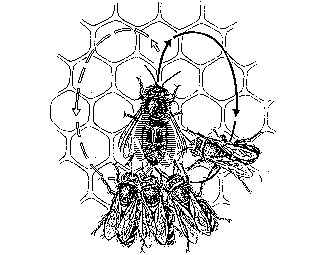
This dance is performed as an indication that food sources are distant, about 100 metres away from the colony. This dance involves running straight forward a short distance, then returning to the starting point by executing a semi-circle, then straight again, followed this time by a semi-circle in the opposite direction. Such a dance may proceed for several minutes at the same spot. This dance is most easily distinguished from the round dance by noting the rapid tail-movement which occurs on the straight forward runs of the tail-wagging dance. The dance varies depending on just how far away the food source is. The greater the distance, the more accurately and slowly the turns are executed, while the more persistent and emphatic the straight runs become. In order to communicate that a food source is 100 metres away, the straight run is performed nine or ten times in 15 seconds. Six straight runs indicate a distance of 500 metres. Four or five straight runs indicate a distance of 1000 metres. One straight run indicates a distance of 10,000 metres.
This knowledge of distance is very useful, however, without knowledge of direction, it is rather useless for the honeybee. To obtain and communicate directional information, the sun is used as a compass. When the foraging bee (soon to take the role of the lead dancer) flies from hive to food source, with the sun at an angle of say, 40 degrees to the left and in front of her, she reproduces this angle in her dance, thus indicating the location of the food. Inside the hive, where sunlight does not penetrate, gravity is used as a compass: upward wagging indicates that the food source is located towards the sun, while downward wagging indicates the opposite direction. If the upward wagging is 60 degrees to the left of the vertical, this indicates that the food source is 60 degrees to the left of the sun.
Dancing in the dark
What comes as a surprise to the human observer, is that the dances are performed in utter darkness, so the recruits follow the lead dancer through their senses of hearing, smell and touch. As the bees dance, they emit low-frequency sounds, which vibrate the honeycomb under the bees' feet, inspiring other bees to join in. The sounds emitted by the lead dancer differ from those emitted by the recruits. Actually it is only the recruits which vibrate the honeycomb, while the lead dancer transmits sound signals directly through the air. This way, the leader's instructions and the recruits demands are not confused. The leader generates sound by beating her wings, conveying details as to the location of the food source. The recruits produce sound by pressing the thorax against the honeycomb, resulting in production of vibrations which alert the leader to the recruits' requests for food samples.
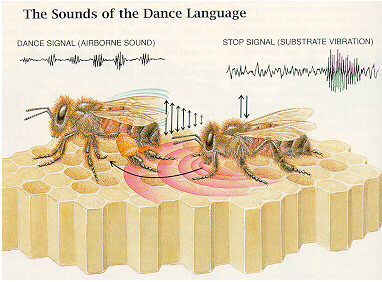
 Bee-home Again |
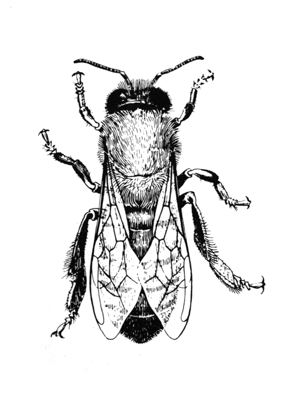 Colony: Division of Labour |
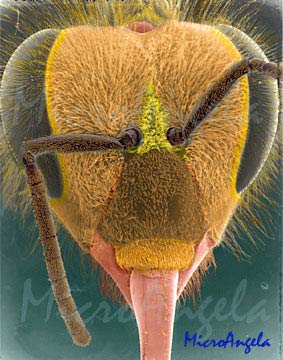 Defensive Mechanisms |
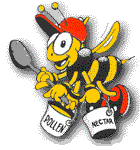 Foraging |
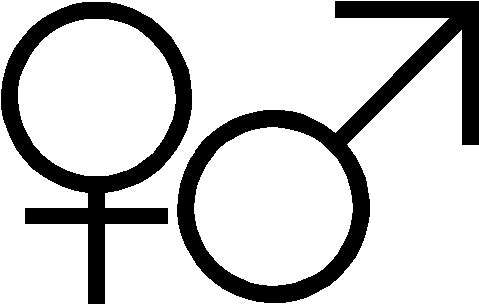 Mating |